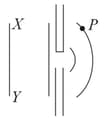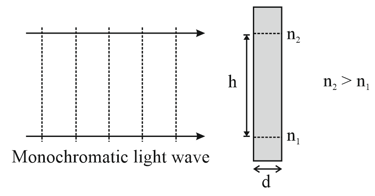A monochromatic plane wave of speed c and wavelength is diffracted at a small aperture. The diagram illustrates successive wavefronts (vibrating in same phase). After what time will some portion of the wavefront reach ?


Important Questions on Wave Optics
(Planck's constant electron mass )
On a hot summer night, the refractive index of air is the smallest near the ground and increases with a height from the ground. When a light beam is directed horizontally, the Huygens' principle leads us to conclude that as it travels, the light beam,
How fast would a rocket have to go relative to an observer for its length to be corrected to of its length at rest?
Given below are two statements: one is labelled as Assertion A and the other is labelled as Reason R
Assertion A: The phase difference of two light waves change if they travel through different media having same thickness, but different indices of refraction.
Reason R: The wavelengths of waves are different in different media.
In the light of the above statements, choose the most appropriate answer from the options given below
A monochromatic light wave is incident normally on a glass slab of thickness , as shown in the figure. The refractive index of the slab increases linearly from to over the height . Which of the following statement(s) is(are) true about the light wave emerging out of the slab?

Which of the following are true?
A. Speed of light in vacuum is dependent on the direction of propagation.
B. Speed of light in a medium is independent of the wavelength of light.
C. The speed of light is independent of the motion of the source.
D. The speed of light in a medium is independent of intensity.
Choose the correct answer from the question given below :

